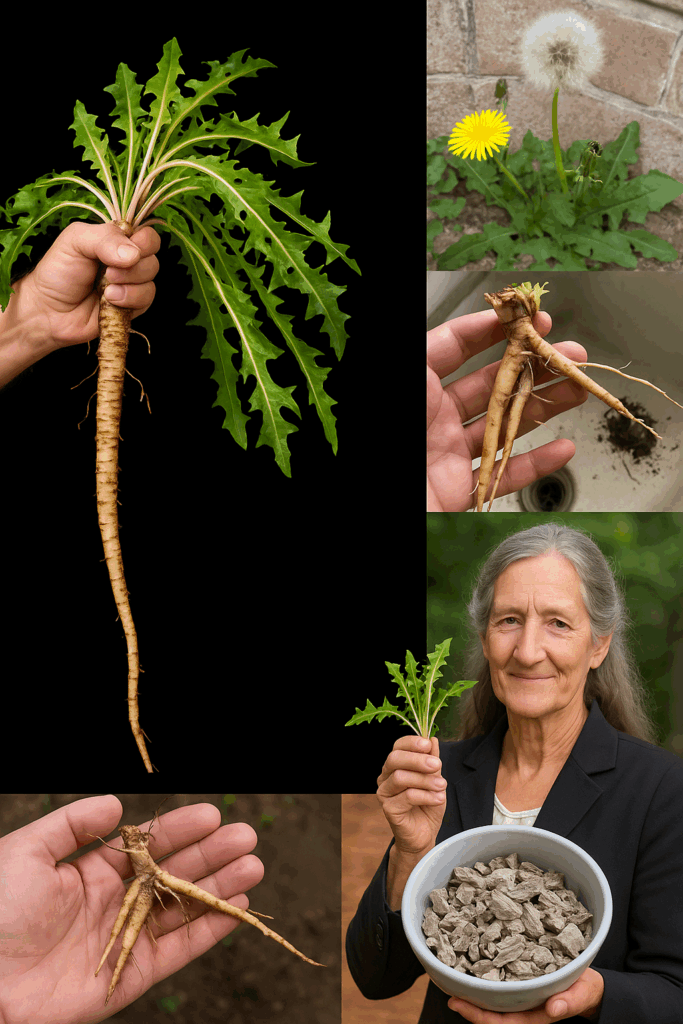Picture a humble dandelion, its golden blooms brightening a lawn, its wispy seeds floating on the breeze. Most of us admire its cheerful flowers or nutrient-packed leaves, but the true treasure lies hidden below the soil. Dandelion roots (Taraxacum officinale) are the unsung heroes of this resilient plant, brimming with medicinal, nutritional, and culinary potential. Far from a mere weed, the dandelion’s root system unlocks a world of health benefits and practical uses that can transform your wellness routine and kitchen creations. This expert guide dives deep into why dandelion roots are the plant’s most vital component, blending science, tradition, and innovation to inspire you to embrace their hidden power.

Unveiling the Dandelion’s Anatomy
🌿 To appreciate the magic of dandelion roots, let’s first explore the plant’s structure. A perennial herb in the Asteraceae family, Taraxacum officinale is a marvel of nature, with each part serving a unique purpose:
- Leaves: Packed with vitamins A, C, and K, plus minerals like calcium and potassium, dandelion greens are a superfood for salads and teas.
- Stems: The milky sap in dandelion stems has been used traditionally for its potential skin-healing properties.
- Flowers: Vibrant and pollinator-friendly, dandelion blooms are crafted into wines, infusions, or used symbolically to represent resilience.
- Roots: The deep, robust taproot is the plant’s lifeline, storing nutrients and bioactive compounds that make it a cornerstone of herbal medicine and culinary arts.
While every part of the dandelion shines, the roots stand out for their unparalleled versatility and potency, making them the plant’s most essential element.
The Medicinal Marvels of Dandelion Roots
🌱 Dandelion roots have been revered for centuries in traditional medicine, from ancient herbalists to modern naturopaths. Modern science is catching up, revealing a wealth of health benefits backed by bioactive compounds like inulin, taraxasterol, and polyphenols. Here’s why dandelion roots are a wellness game-changer:
1. Boosts Liver Health and Detoxification
🧹 Dandelion roots are a liver’s best friend. They stimulate bile production, enhancing digestion and supporting the liver’s role in detoxifying the body. Their natural diuretic properties promote kidney function, helping flush out toxins and reduce water retention. Regular use may improve liver enzyme levels, offering a gentle cleanse for optimal organ health.
2. Enhances Digestive Wellness
🍵 Struggling with bloating or sluggish digestion? Dandelion root tea soothes upset stomachs, relieves constipation, and fosters a balanced gut microbiome. Its high inulin content, a prebiotic fiber, nourishes beneficial gut bacteria, making it a natural remedy for conditions like irritable bowel syndrome (IBS).
3. Fights Free Radicals with Antioxidants
🛡️ Packed with beta-carotene, polyphenols, and other antioxidants, dandelion roots neutralize harmful free radicals that contribute to aging and chronic diseases. These compounds may reduce oxidative stress, supporting heart health, immune function, and overall vitality.
4. Reduces Inflammation
💪 Chronic inflammation fuels ailments like arthritis and cardiovascular disease. Dandelion roots contain anti-inflammatory compounds like taraxasterol, which may alleviate swelling, joint pain, and other inflammatory symptoms, offering a natural alternative to synthetic drugs.
5. Shows Promise in Cancer Research
🔬 Emerging studies suggest dandelion root extract may inhibit the growth of certain cancer cells, such as those in breast and prostate cancers, by inducing apoptosis (cell death). While not a cure, its potential as a complementary therapy is sparking excitement in the scientific community, warranting further research.
Culinary Creativity with Dandelion Roots
🍴 Beyond their medicinal prowess, dandelion roots are a culinary delight, offering earthy, nutty flavors that elevate dishes. Their versatility makes them a favorite among foragers and foodies alike. Here are five inspired ways to bring dandelion roots to your table:
1. Roasted Dandelion Root Coffee
☕ Roast cleaned dandelion roots at 350°F for 20-30 minutes until dark and fragrant, then grind into a coarse powder. Brew like coffee for a rich, caffeine-free alternative with a bold, slightly bitter taste. This beverage is a cozy, liver-supporting treat.
2. Crispy Dandelion Root Chips
🍟 Thinly slice fresh roots, toss with olive oil and sea salt, and bake at 400°F for 15-20 minutes until crisp. These nutrient-dense chips are a wholesome snack, perfect for replacing processed potato chips.
3. Hearty Dandelion Root Soup
🥣 Boil or blanch diced dandelion roots and add them to vegetable or chicken soups. Their subtle earthiness enhances broths, pairing beautifully with carrots, leeks, or herbs like thyme for a comforting, nutrient-rich meal.
4. Dandelion Root Salad
🥗 Blanch chopped roots briefly to soften, then toss with greens, nuts, and a citrus vinaigrette. The roots add a unique texture and mild bitterness, elevating your salad into a gourmet experience.
5. Dandelion Root Infusion
🫖 Steep dried or fresh roots in hot water for 10-15 minutes to create a soothing tea. Add honey or lemon for flavor, and sip to support digestion, detoxification, or relaxation.
Practical Uses Beyond the Kitchen
🔧 Dandelion roots extend their value beyond health and cuisine. Their deep taproots improve soil health by breaking up compacted earth and drawing nutrients to the surface, making them a gardener’s ally. In traditional crafts, roasted roots have been used as a natural dye, imparting warm, earthy tones to fabrics. These practical applications highlight the root’s multifaceted role in sustainable living.
Harvesting and Preparing Dandelion Roots
🌾 To unlock the benefits of dandelion roots, proper harvesting and preparation are key:
- When to Harvest: Dig roots in early spring or late fall when nutrient stores are highest. Choose plants from clean, pesticide-free areas.
- How to Harvest: Use a garden fork to gently lift the taproot, preserving its length. Rinse thoroughly to remove soil.
- Preparation: Scrub roots clean, chop for teas or cooking, or dry at low heat (under 150°F) for long-term storage. Store dried roots in airtight containers away from light.
Safety and Considerations
⚠️ Dandelion roots are generally safe for most people, but precautions ensure a positive experience:
- Allergies: Those allergic to Asteraceae plants (like ragweed) may experience reactions. Start with small amounts.
- Medical Conditions: Consult a healthcare provider if you have gallstones, kidney issues, or are on diuretics, as dandelion’s effects may interact.
- Pregnancy and Nursing: Limited data exists, so seek medical advice before use.
- Foraging: Avoid plants near roadsides or chemically treated areas to prevent contamination.
Why Dandelion Roots Reign Supreme
🌟 While dandelion leaves and flowers have their merits, the roots are the plant’s powerhouse, offering unmatched medicinal, culinary, and ecological benefits. Their ability to support liver health, fight inflammation, and inspire creative recipes sets them apart. A single root can yield tea, snacks, or remedies, making it a sustainable, cost-effective resource. By tapping into this underground treasure, you’re not just enhancing your health—you’re embracing a plant that has sustained humanity for centuries.
Embrace the Dandelion Root Revolution
The next time you spot a dandelion in your yard, don’t reach for the weed killer. Instead, dig deeper to uncover the root’s hidden gifts. Whether you’re sipping a warm cup of dandelion root tea, snacking on crispy root chips, or soothing your body with its medicinal magic, this remarkable plant invites you to rethink what a weed can do. Start your dandelion root journey today, and let its underground power transform your health, your kitchen, and your connection to nature.


